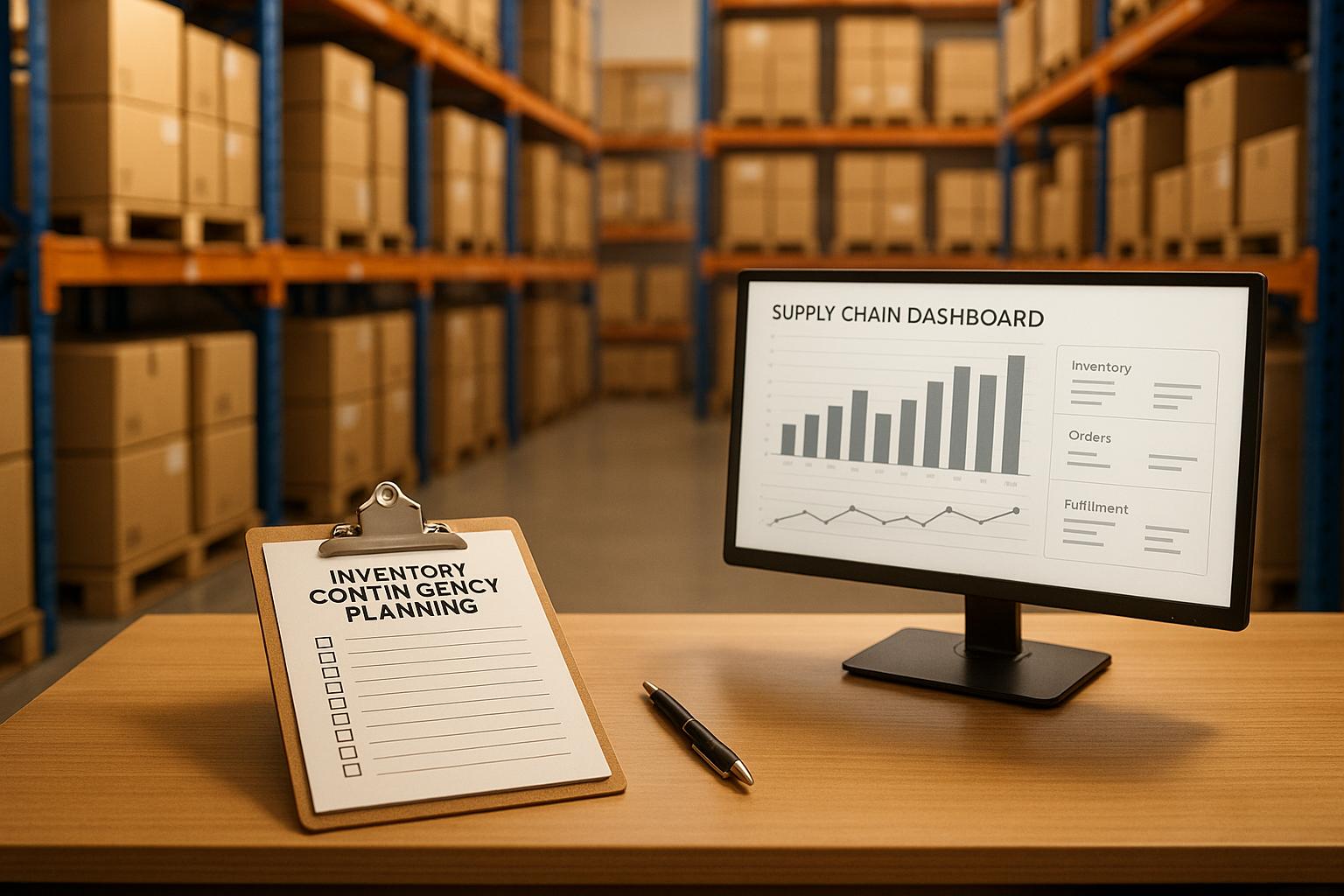Ultimate Guide to Inventory Contingency Planning

Inventory disruptions can cost businesses revenue, increase storage expenses, and harm customer satisfaction. A solid inventory contingency plan helps you prepare for supply chain issues, demand spikes, and other unexpected challenges. Here’s what you’ll learn:
- Key Risks: Demand volatility, supply chain delays, warehouse issues, and natural disasters.
- US-Specific Challenges: Multi-channel selling, regional demand variations, fast shipping expectations, and regulatory compliance.
-
Planning Steps:
- Assess risks using data and supply chain mapping.
- Set goals and measurable KPIs.
- Develop response strategies like backup suppliers and inventory reallocation.
- Train your team with clear roles and communication protocols.
- Test and update the plan regularly.
- Managing Shortages and Overstock: Use safety stock, real-time tracking, promotions, and flexible storage options.
- 3PL Support: Third-party logistics providers can help with inventory redistribution, real-time tracking, and flexible solutions.
A proactive plan ensures smooth operations during disruptions, reduces costs, and keeps customers satisfied.
What Is A Supply Chain Contingency Plan? - BusinessGuide360.com

Key Inventory Risks and Vulnerabilities
Understanding and assessing inventory risks is crucial for creating a solid contingency plan. These risks can arise from any part of your supply chain, often compounding into major business challenges.
Common Inventory Risks
The complexities of the U.S. market bring several inventory risks to the forefront. Demand volatility is one of the toughest challenges for e-commerce businesses. Sudden surges in demand - driven by unpredictable market trends or seasonal events - can be hard to predict. Without sufficient safety stock, businesses risk stockouts and revenue losses.
Supply chain issues are another major concern, as disruptions can occur at multiple points. Supplier problems, such as manufacturing delays, quality issues, financial instability, or contract disputes, can leave businesses scrambling for alternatives, often at higher costs and longer lead times. Transportation failures, including port congestion, trucking strikes, or limited carrier capacity, can also delay shipments significantly.
Warehouse and fulfillment center challenges can directly disrupt operations. Equipment breakdowns, labor shortages, system outages, or space constraints can slow down order processing and shipments - especially during high-demand periods like Black Friday or the holiday season.
Natural disasters and extreme weather add another layer of risk. Hurricanes, wildfires, and severe winter storms can simultaneously disrupt supplier operations, transportation routes, and storage facilities, creating widespread supply chain chaos.
Risk Assessment Methods
Accurate risk assessment relies heavily on data-driven approaches. Historical data analysis is a key tool, as it reviews past trends in demand, supplier performance, and disruptions to identify patterns and vulnerabilities.
Statistical safety stock calculations provide a quantitative way to manage fluctuations in demand and lead time. This method uses metrics like demand variability (σD), lead time variability (σLT), and a service-level factor (Z-factor) to calculate the right buffer inventory.
For example, in April 2025, a paper-forming company analyzed weekly demand over a year using a histogram. Without safety stock, stockouts occurred in half of their cycles. By introducing safety stock equal to one standard deviation (28 rolls), they covered demand for 84% of cycles, avoiding stockouts in 44 out of 52 weeks.
Business Impact Analysis (BIA) helps prioritize risks by assessing their financial and operational consequences. This involves calculating stockout costs - such as lost sales, expedited shipping, and customer acquisition expenses - and setting service levels for different products based on their strategic importance, profit margins, or sales volumes.
Economic Order Quantity (EOQ) analysis is another key method. It minimizes total costs by balancing procurement expenses with inventory holding costs. This analysis considers factors like average demand, procurement costs, holding costs, and opportunities for quantity discounts.
Forecast error analysis evaluates how accurate demand predictions are by measuring forecast error standard deviation. This helps determine appropriate safety stock levels and pinpoints areas where forecasting methods need improvement.
Regional and Regulatory Factors
The U.S. market poses unique challenges that require specialized risk management strategies. Regulatory compliance risks complicate inventory management, especially for FDA-regulated products that require specific storage conditions and documentation. State-specific regulations, like California's Proposition 65 or varying tax rules, further influence how inventory is allocated and distributed.
Infrastructure vulnerabilities are another significant factor. For instance, the Ports of Los Angeles and Long Beach handle about 40% of U.S. container imports, making them critical chokepoints. Similarly, major trucking routes like Interstate 95 on the East Coast and Interstate 5 on the West Coast represent single points of failure in regional distribution networks.
Labor market dynamics also play a role. Regions with tighter labor markets may face higher turnover rates and wage pressures, which can disrupt warehouse operations and shipping reliability.
Economic retention limits help businesses determine the maximum inventory they can hold without incurring excessive costs. This is especially important for seasonal items or products with limited shelf life, where local demand patterns may vary significantly. Regular analysis of stock levels against projected usage helps prevent overstock losses, while also identifying opportunities to transfer stock between locations.
How to Create an Inventory Contingency Plan
Crafting an inventory contingency plan takes careful planning and a structured approach tailored to your business's unique risks and operational requirements. Here's a five-step guide to help you design a plan that minimizes disruptions and keeps your operations running smoothly.
Step 1: Assess Risks
Start by identifying the risks that could impact your inventory. Take into account your business model, supply chain, and geographic locations.
- Develop a risk matrix: Evaluate potential disruptions based on their likelihood and impact. For example, a supplier going bankrupt might score a 2 for likelihood and a 5 for impact (total score = 10), while weather delays could score a 4 for likelihood and a 2 for impact (total score = 8). Use these scores to prioritize risks.
- Map your supply chain: Highlight areas of dependency, such as single-source suppliers or critical transportation routes. Pay special attention to suppliers that account for more than 20% of your inventory value, as they pose higher risks.
- Analyze product turnover: Use 12–24 months of warehouse management system (WMS) data to understand turnover rates. Fast-moving items with short lead times will need different strategies than slower-moving, high-value items with long procurement cycles.
Step 2: Define Goals and KPIs
Set clear objectives for your contingency plan. These goals should include measurable targets:
- Service levels (e.g., 99% for premium customers, 95% for standard).
- Spending limits (e.g., up to 150% of normal costs, with escalation thresholds).
- Response times (e.g., 48 hours for minor delays, 72–96 hours for major disruptions).
- Inventory thresholds that trigger backup actions (e.g., 15, 10, and 5 days of supply left).
Step 3: Develop Response Strategies
Prepare actionable steps for each risk scenario to ensure your team can act quickly and effectively during disruptions.
- Pre-qualify backup suppliers: Secure at least two alternative suppliers for items that make up more than 10% of your inventory value. Negotiate agreements that allow for rapid scaling of orders in emergencies.
- Reallocate inventory as needed: Set up protocols for transferring inventory between warehouses, including expedited shipping arrangements. Consider working with third-party logistics (3PL) providers like JIT Transportation, which offer flexible distribution networks and technology to handle disruptions.
- Streamline emergency purchasing: Create pre-approved vendor lists, spending limits, and quality standards to bypass lengthy approval processes while maintaining control. Clearly document who has the authority to make emergency purchases.
- Communicate with customers: Prepare templates for notifying customers about delays, shortages, or stockouts. Include estimated resolution times, alternative product options, and any compensation or priority handling you may offer.
Step 4: Train Your Team
A well-prepared team is essential for executing your plan effectively.
- Assign roles and backups: Clearly define responsibilities for tasks like supplier communication, inventory reallocation, and customer updates. Document contact details, decision-making authority, and escalation procedures for each role.
- Establish communication protocols: Set up dedicated channels, such as Slack groups or group texts, to ensure quick and accurate information flow during disruptions. Define reporting schedules, such as hourly updates for the first 24 hours of a major issue.
- Collaborate with external partners: Share relevant parts of your plan with suppliers, logistics providers, and key customers. Train them on their roles and establish priority handling procedures for emergencies.
- Clarify decision-making authority: Specify who can approve emergency actions, allocate inventory, and communicate publicly about supply issues. Create clear escalation paths for situations when key personnel are unavailable.
Step 5: Test and Update the Plan
Regular testing and updates ensure your plan remains effective and relevant.
- Run quarterly exercises: Simulate realistic scenarios, like a supplier shutdown or a weather-related warehouse closure, to evaluate your team's response. These drills help identify gaps in procedures and communication.
- Use varied testing methods: Conduct checklist reviews to verify contact details and procedures, walk-through exercises to practice emergency actions, and parallel simulations to test backup systems without disrupting daily operations.
- Review the plan regularly: Update the plan at least twice a year, or more frequently after significant changes or actual disruptions. Revise supplier details, contact lists, and inventory thresholds as needed.
- Evaluate post-incident performance: After any disruption, document what worked, what didn’t, and what resources were lacking. Use these insights to improve your procedures and training.
- Keep documentation current: Assign team members to update specific sections of the plan on a rotating schedule. For example, verify supplier information monthly and review inventory thresholds quarterly.
A well-tested and updated contingency plan equips you to handle inventory challenges effectively, ensuring your business can adapt to shortages and overstock situations with minimal disruption.
sbb-itb-eafa320
Managing Inventory Shortages and Overstock
Effectively managing inventory imbalances is key to cutting costs and keeping customers happy. By using tailored strategies, businesses can navigate the risks of shortages and overstock while maintaining smooth operations. Here’s how to tackle both challenges head-on.
Handling Inventory Shortages
When inventory runs low, quick action is essential. Start by calculating and regularly reviewing safety stock levels. This involves factoring in daily usage and lead-time variability, especially for items with seasonal demand or unpredictable buying patterns.
Real-time tracking is another critical tool. Set up automated alerts to notify your team when stock is nearing a predefined threshold. These alerts provide the time needed to adjust orders and prevent stockouts.
If shortages do occur, having backup suppliers in place can save the day. Build relationships with alternate vendors who meet your quality standards and can step in quickly when needed. Clear documentation of these standards and approval processes will help streamline emergency sourcing.
During periods of unexpected demand, expedited shipping can bridge the gap. While it may come at a higher cost, it can be a lifesaver in preventing lost sales.
Another option is product substitution. Train your customer service team to offer acceptable alternatives and include perks like expedited shipping to keep customers satisfied during shortages.
Managing Overstock Situations
Excess inventory can tie up valuable resources, but there are ways to turn it around. Liquidating surplus stock through B2B platforms is one option, depending on the condition of the products and current market interest.
Promotions can also help move slow-moving items. Consider bundling them with popular products, offering volume discounts, or running limited-time deals to clear out inventory while maintaining your brand’s image.
Flexible storage agreements are another smart move. Negotiate terms that allow you to scale warehouse space based on seasonal needs and inventory levels, which helps optimize costs and capacity.
Cross-docking operations can reroute surplus inventory directly to areas with higher demand. This reduces storage requirements and speeds up delivery times.
Finally, include return-to-vendor agreements in your purchasing contracts. These agreements let you return unsold items under prearranged terms, reducing the financial impact of overstock.
How 3PL Partners Support Contingency Plans
Third-party logistics (3PL) providers can play a crucial role in managing inventory challenges. They offer specialized infrastructure and expertise to address both shortages and overstock efficiently. For instance, JIT Transportation’s nationwide network enables rapid inventory reallocation, minimizing the impact of regional disruptions.
Their technology goes a step further, offering real-time tracking, automated reordering, and predictive analytics to address supply issues before they escalate.
Additionally, 3PLs can help transform surplus inventory into new opportunities through value-added services like pick & pack, kitting, assembly, and testing. With options like white glove handling and tailored logistical solutions, businesses can adapt quickly without committing to long-term contracts. This flexibility ensures your contingency plans remain strong, whether you’re facing a surge in demand or a supply shortfall.
Building Supply Chain Resilience with 3PL Providers
Supply chain disruptions are inevitable, but third-party logistics (3PL) providers offer the tools and expertise to keep operations running smoothly, even during challenging times.
Benefits of 3PL Partnerships for Resilience
One major advantage of partnering with a 3PL is geographic diversification. By spreading inventory across multiple warehouses, businesses can reduce the impact of regional disruptions. For instance, if a hurricane hits the Southeast, operations can continue uninterrupted with inventory from the Midwest or West Coast.
Another key benefit is scalable infrastructure, which allows businesses to respond quickly to shifts in demand without the need for hefty investments in new facilities. Whether it’s a holiday rush or an unexpected spike in orders, 3PL providers can ramp up warehouse space and labor resources in a matter of days, not months.
The shared risk model of 3PL partnerships also helps businesses avoid shouldering the full cost of supply chain disruptions. These providers have already invested in backup systems, alternative transportation routes, and emergency protocols, making it easier and more affordable for businesses to stay resilient.
Additionally, 3PL providers offer access to multiple transportation modes, which is crucial during times of disruption. If trucking capacity becomes constrained, they can tap into their network of rail, air, and ocean carriers to find alternative shipping solutions. This flexibility ensures goods keep moving, no matter the challenges.
These advantages are exemplified by companies like JIT Transportation, which specializes in contingency planning.
JIT Transportation's Contingency Planning Support

JIT Transportation leverages its nationwide network to provide comprehensive inventory coverage. With warehouses strategically located across the U.S., they can quickly redistribute inventory to ensure orders are fulfilled, even during disruptions.
Their diverse service portfolio adds flexibility when standard shipping methods are unavailable. Whether it’s handling fragile items or prioritizing urgent deliveries, JIT Transportation ensures customers receive their orders without compromising quality.
Value-added services like pick-and-pack, kitting, assembly, and testing give businesses the ability to maintain product customization and quality control. When primary suppliers face delays, these services allow companies to source components elsewhere and complete assembly at JIT’s facilities.
Through their vendor-managed inventory (VMI) program, JIT Transportation monitors stock levels in real time and automatically triggers replenishment orders. This proactive approach reduces the risk of stockouts during busy periods, freeing internal teams to focus on other critical tasks.
Their returns management (RMA) services also play a vital role in maintaining customer satisfaction during disruptions. By efficiently handling returns and exchanges, businesses can preserve customer loyalty, even when other parts of the supply chain are under strain.
Backing these services is advanced technology integration, which further strengthens supply chain resilience.
Technology and Logistics Integration
ERP integration ensures seamless communication between your business systems and your 3PL provider. With real-time inventory visibility across all locations, businesses can make faster decisions during disruptions. For example, you can instantly identify where stock is available and reroute orders without manual intervention.
Automated reordering systems use demand forecasting and historical data to maintain optimal inventory levels. These systems can detect unusual trends that signal potential supply chain issues and adjust orders before problems escalate.
With real-time tracking, businesses gain full visibility into shipments. When delays occur, customer service teams can proactively inform customers about the status of their orders, setting realistic expectations rather than leaving them in the dark.
Pool distribution and consolidation services further enhance efficiency by combining shipments from multiple suppliers or to multiple destinations. This approach maximizes transportation resources and reduces per-unit shipping costs, which is especially valuable during capacity shortages.
Key Takeaways on Inventory Contingency Planning
Here’s a quick recap of the key points from our in-depth guide.
A well-thought-out contingency plan is a game-changer, helping businesses maintain smooth operations even when disruptions hit. Leading e-commerce companies recognize that while disruptions are unavoidable, their effects don’t have to derail the entire operation.
At the heart of a strong contingency plan lies risk assessment. Identifying vulnerabilities - like reliance on specific suppliers or seasonal demand spikes - is crucial. Businesses that succeed are those that pinpoint risks and develop targeted strategies to address them.
Setting clear objectives and measurable KPIs turns contingency planning into a practical, results-driven approach. For example, aiming for a 95% order fulfillment rate during peak seasons or maintaining optimal safety stock levels provides clear benchmarks for success.
Take JIT Transportation as an example: their extensive 3PL network offers geographic diversification, which helps mitigate regional disruptions. Beyond that, their value-added services - like pick-and-pack operations or assembly - allow businesses to pivot quickly when primary suppliers face setbacks.
Technology integration is another cornerstone of effective planning. Tools like real-time inventory tracking, automated reordering systems, and ERP integration empower businesses to make quick, data-driven decisions in critical moments. Companies with access to accurate, up-to-date information bounce back faster from disruptions than those relying on outdated systems.
Lastly, contingency planning isn’t a one-and-done task. Regular testing and updates ensure your plan stays relevant as your business evolves and market conditions shift. Investing time and resources in proactive planning pays off when challenges arise, allowing you to keep customers happy and operations steady while competitors scramble to respond.
FAQs
What’s the best way to balance safety stock costs with the risk of running out of inventory during sudden demand spikes?
To manage the delicate balance between safety stock costs and the risk of running out of stock during demand surges, businesses should prioritize precise demand forecasting and adaptive inventory management. By digging into historical sales data, keeping an eye on market trends, and accounting for seasonal shifts, businesses can better predict when and how demand might fluctuate, allowing for smarter adjustments to safety stock levels.
It's also crucial to factor in elements like lead times, desired service levels, and demand variability when determining safety stock thresholds. Using flexible restocking strategies and tapping into advanced inventory management tools can help strike the right balance - keeping enough stock on hand to meet unexpected demand without tying up resources in excess inventory. This proactive strategy can prepare businesses for demand spikes while avoiding the pitfalls of overstocking or costly shortages.
What strategies can businesses use to meet U.S. regulatory requirements in their inventory contingency plans?
To meet U.S. regulatory requirements for inventory contingency planning, businesses need to prioritize regular audits and quality control checks to consistently uphold standards. Keeping comprehensive records of inventory activities - like purchase orders, sales, and stock movements - is crucial for maintaining transparency and adhering to compliance guidelines.
In addition, companies should establish well-defined compliance policies, invest in dependable inventory management systems, and offer continuous training to employees on applicable regulations. These measures not only help businesses stay compliant but also reduce risks during unforeseen disruptions.
How can third-party logistics providers help strengthen supply chains during natural disasters or disruptions?
Third-party logistics providers (3PLs) play a key role in keeping supply chains steady during natural disasters or other disruptions. By spreading inventory across different locations, they reduce the risk of everything grinding to a halt due to a single point of failure. This approach ensures that goods remain accessible, even when certain areas are affected.
On top of that, 3PLs leverage cutting-edge technology and their deep industry know-how to tackle unexpected challenges head-on. Whether it’s rerouting shipments, tweaking transportation plans, or quickly deploying resources, they work to keep operations on track. Their ability to offer flexible and dependable support helps businesses bounce back faster and maintain customer trust during tough times.
Related Blog Posts
Related Articles

How to Track Reverse Logistics Metrics

Best Practices for Renewable Energy in 3PL Operations

